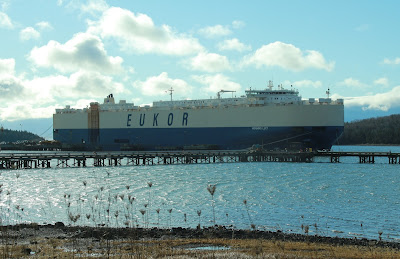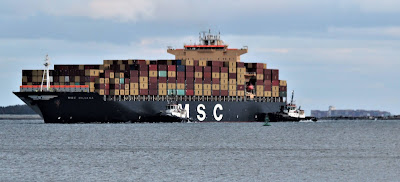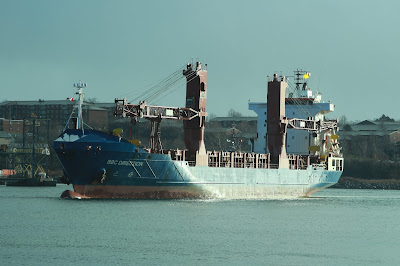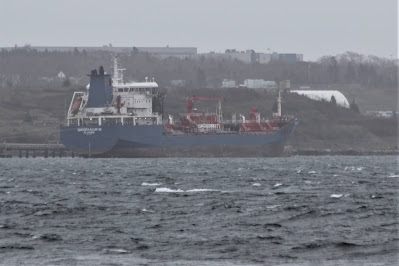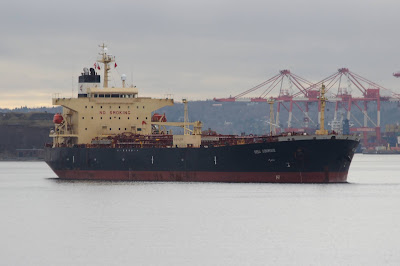On November 21, 1970 the container / RoRo vessel Atlantic Cinderalla (738 TEU) became the first ship to tie up at the new Southend container terminal in Halifax. Container ships had been calling at other piers in Halifax for more than a year while the terminal was under construction, but this was the first to use the new facility including its specially built Canron container cranes, and a RoRo ramp. Atlantic Container Line was one of two "pioneer" container lines to call in Halifax.
Atlantic Cinderella was the first customer at the new pier.
The other "pioneer" line, Dart Container Line, had been using chartered ships but its new ships were soon completed and began to use the new facility too.
A view from the adjacent Point Pleasant Park in 1971. On the extreme left is the former Royal Nova Scotia Yacht Squadron building. The club and yacht basin were relocated to the Northwest Arm to make room for the container pier.
The new terminal's pier, built roughly perpendicular to the existing finger Pier B was designated Pier C with berths numbered 41 and 42. It has since been extended twice and can accommodate the largest container ships calling at any Canadian port. Its cranes and other equipment have also been upgraded.
The new pier begins to the right of centre. The large sheds on Pier B (just to the right of centre) have long since been demolished, as have the freezer buildings to the far left.
(1973 view)
The pier's most important customer for many years has been ZIM (Zim Integrated Shipping Services Ltd). The publicly owned company is headquartered in Israel. (1975 view)
The terminal was operated by a company called Halterm, which name was also applied to the entire facility. Macquarie became the owners of Halterm in 2007 and they sold the operation to PSA in 2019. PSA has since renamed the terminal PSA Halifax.
The trees have grown as has the container terminal, so the above view from 1971 is almost unbelievable today.
The ships have grown in size too:
Dart Europe, built in 1970, was a large ship in its day, measuring 31,611 gt, 28,034 dwt, and had a capacity of 1,000TEU.
All the orginal cranes have been replaced with higher units with longer reach:
The ACL and Dart ships pale in comparison with the 15,000 TEU ships of today.
Sadly, the expansion of the terminal over the years has meant the loss of the delightful little lighthouse that was perched at the end of the breakwater.
The pier has been extended south (to the right in the photo) past the end of the breakwater:
Although the walkway extends around the end of the pier, it is seldom open, and when it is, visitors are greeted by unfriendly signs:
A present day view shows the most recent extension (to the right). The walkway is closed when any cranes are overhanging it - which is almost always - and for the winter. The extension was termed "temporary" when it was initialy proposed, but no one believed that, and the term is no longer applied.Now plans are afoot to re-organize some of the shoreside areas again, expanding the container storage areas, the rail lines and the staff parking. A new truck gate and likely re-alignment of the marginal road are also in the works. At least one more crane is on order and other equipment as well. As the premier Canadian container terminal on the east coast, PSA Halifax will continue to be a major component of the Port of Halifax.
Much of the open area outside the fence may be included in the expanded shore side facilities.
The PSA terminal now includes the Pier B and Pier C areas, totaling 76.5 acres (31 Hectares) with five super post panamax cranes. There are 714 on ground reefer plugs and the current annual throughput is 500,000 TEU. Pier C itself is now more than a km long, and additional finger pier berths are now within the terminal and include berths 30-31, 33-34 and 36-37 and 39.
I suggested the above idea when the last extension of the pier (in red) was announced, but it is more likely that the space between the finger piers A-1 and B will be filled in instead. I hope that the grain terminal will be retained as a national asset, and the space between Pier A and A-1 will not be filled in.
In this older plan, the latest pier extension is not shown. Also the balloon or loop track, around the perimeter of the terminal has since been removed. It was used to turn passenger trains around, as Halifax is the end of the line. However it was apparently a major nuisance for the terminal operations. Trains are no longer turned - the engines are now paired end to end and just move from one end of the train to the other when they reach Halifax. Crane tracks extending out along the north face of Pier B are also no longer in use - the present cranes are a wider gauge.
With the current boom in container shipping (shipping line profits have never been higher) but a huge imbalance between supply / demand and location of containers, not to mention shoreside congestion in many ports, Halifax remains - at least so far - free from backups and delays, but the PSA facility is crowded and more space is certainly needed.

New RTGs (Rubber Tired Gantries) that can stack containers five high, have replaced older units that could only reach four high. This has increased the storage capacity of the terminal, but space is still at a premium.
One of the early customers of Halterm was HAPAG-Lloyd. They also operated a feeder service from Halifax to US ports using the Yankee Clipper.
Yankee Clipper at Pier 36 with one of the Canron "Portainer" cranes in the background.
Before the first extension, the breakwater extended beyond the pier face and this view of activities was possible. However the breakwater was cut off when the pier was extended southward.
Now the pier extends so far south (right) of the breakwater that it can accommodate an entire ship.This allows PSA Halifax to work two "Ultra" size container ships (more than 10,000 TEU capacity) at the same time.


